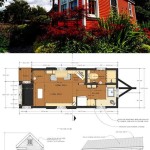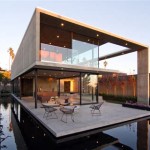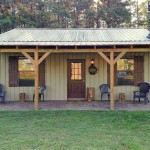Design Your Dream Home With House Plans Featuring a Lanai
The concept of home design is constantly evolving, reflecting changing lifestyles and preferences. One increasingly popular feature in modern house plans is the lanai. A lanai, typically understood as a covered outdoor living space, offers a seamless transition between indoor comfort and the beauty of the surrounding environment. Incorporating a lanai into your home design allows you to maximize living space, expand entertainment possibilities, and enhance the overall aesthetic appeal of your property. This article examines key considerations for integrating a lanai into your house plans.
Understanding the Lanai and Its Benefits
A lanai is more than just a porch or patio. It is a structured extension of the interior, often under the same roof as the main house. This architectural integration offers protection from the elements, providing a sheltered space that can be enjoyed year-round, depending on the climate. Lanais can be simple, featuring just a roof and open sides, or more elaborate, with screens, walls, or even retractable glass panels to provide climate control and privacy. The versatility of the lanai makes it an attractive option for homeowners seeking to expand their usable living area without the expense and complexity of a full room addition.
The benefits of including a lanai in house plans are multifaceted. Firstly, it provides an outdoor living space that can be used for dining, relaxing, or entertaining. A lanai can serve as an extension of the living room or kitchen, creating a fluid indoor-outdoor connection. This is particularly beneficial for homes in warmer climates, where outdoor living is prevalent. Secondly, a lanai can enhance the aesthetic appeal of a home. The design can be tailored to complement the overall architectural style of the house, adding visual interest and curb appeal. Thirdly, a lanai can increase the value of a property. The addition of functional and aesthetically pleasing outdoor living space is often seen as a desirable feature by potential buyers.
In selecting house plans with a lanai, consider the lifestyle you wish to encourage. A lanai adjacent to the kitchen might be ideal for frequent outdoor dining, whereas one connected to the master bedroom could serve as a private retreat. Think about the activities you envision using the space for and choose a design that supports those activities. This might involve considering the size of the lanai, its orientation, and the types of features it incorporates.
Key Considerations When Choosing House Plans with a Lanai
Selecting the right house plans with a lanai requires careful consideration of several factors. These include the size and layout of the lanai, its orientation and exposure, the materials used in its construction, and its integration with the rest of the house. Each of these factors can significantly impact the functionality, aesthetic appeal, and overall value of the lanai.
The size of the lanai should be proportionate to the size of the house and the amount of outdoor space available. A small lanai may feel cramped and unusable, while a lanai that is too large may overwhelm the overall design of the house. Consider the intended use of the lanai when determining its size. If you plan to use it for outdoor dining, you will need enough space to accommodate a table and chairs. If you plan to use it for lounging, you will need enough space for comfortable seating. Larger lanais might even incorporate outdoor kitchens or fireplaces.
The layout of the lanai should be carefully planned to maximize its functionality and aesthetic appeal. Consider the placement of doors and windows that connect the lanai to the interior of the house. These should be positioned to create a seamless flow between indoor and outdoor spaces. Also, consider the placement of furniture and other features within the lanai. These should be arranged to create a comfortable and inviting space that is easy to navigate.
The orientation and exposure of the lanai can significantly impact its usability and comfort. Ideally, the lanai should be oriented to maximize sunlight during the cooler months and minimize it during the warmer months. This can be achieved by orienting the lanai to face south or east. Also, consider the prevailing winds in your area. The lanai should be positioned to take advantage of cooling breezes during the summer months and to be sheltered from strong winds during the winter months.
The materials used in the construction of the lanai should be durable, weather-resistant, and aesthetically pleasing. Common materials include wood, concrete, stone, and composite decking. Wood is a classic choice that offers a natural and warm look, but it requires regular maintenance to prevent rot and decay. Concrete is a durable and low-maintenance option, but it can be less aesthetically appealing. Stone is a beautiful and durable option, but it can be more expensive than other materials. Composite decking is a low-maintenance and weather-resistant option that is available in a variety of colors and styles.
Finally, the lanai should be seamlessly integrated with the rest of the house. This means that the design of the lanai should complement the overall architectural style of the house. The materials used in the construction of the lanai should match or complement the materials used in the construction of the house. The lanai should also be easily accessible from the interior of the house. This can be achieved by placing doors and windows that connect the lanai to the main living areas of the house.
Integrating the Lanai with Your Lifestyle
The most successful house plans with a lanai are those that seamlessly integrate the outdoor living space with the homeowner's lifestyle. This requires careful consideration of how the lanai will be used and how it can be designed to support those uses. For example, a family that enjoys outdoor cooking might want to incorporate an outdoor kitchen into their lanai. A couple that enjoys relaxing outdoors might want to create a comfortable seating area with a fireplace or fire pit. A family with young children might want to create a play area in their lanai.
Consider the activities you enjoy and how a lanai could enhance those activities. If you enjoy gardening, you might want to create a lanai with built-in planters or a vertical garden. If you enjoy reading, you might want to create a quiet and comfortable reading nook in your lanai. If you enjoy entertaining, you might want to create a lanai with a bar, a dining area, and a lounge area.
Also, consider the climate in your area. If you live in a warm climate, you will want to design your lanai to provide shade and ventilation. This can be achieved by using screens, fans, and strategically placed plantings. If you live in a colder climate, you will want to design your lanai to provide warmth and shelter. This can be achieved by using heaters, fireplaces, and enclosed walls.
Beyond the foundational structural and material considerations, think about the finer details. Lighting plays a crucial role in setting the mood and extending the usability of the lanai into the evening hours. Consider a combination of ambient lighting, task lighting, and accent lighting to create a layered and inviting atmosphere. Furniture selection is also key. Opt for durable, weather-resistant pieces that are comfortable and stylish. Accessorize with outdoor rugs, pillows, and throws to add color, texture, and personality. Decorative elements, such as potted plants, sculptures, and water features, can further enhance the aesthetic appeal of the lanai.
Ultimately, the goal is to create a lanai that is an extension of your home and a reflection of your personal style. By carefully considering these factors and working with an experienced architect or designer, you can create a lanai that will enhance your life for years to come. The importance of professional guidance cannot be overstated. An architect can help you navigate building codes, ensure structural integrity, and optimize the design for your specific site conditions. They can also offer valuable insights into material selection, lighting design, and space planning.
Considering all these factors will ensure that the inclusion of a lanai will enhance your living space and add value to your home.

Plan 75977 Modern Style House Floor With Covered Lanai

Build A Home On The Beach House Plans Blog Dreamhomesource Com

2 Story Modern House Plan With Lanai

Pin Page

Build A Home On The Beach House Plans Blog Dreamhomesource Com

Plan 86073bw Contemporary 4 Bed House With Study And Covered Lanai

Mediterranean Dream Home Plan Italian Floor

Luxury Beach House Plan 1769

Beautiful Three Bedroom House Plans Blog Floorplans Com

Coastal House Plan Luxury 2 Story West Indies Home Floor
Related Posts








